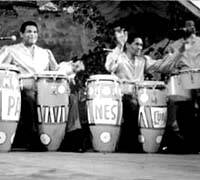9.2 Main musical genres of the 20th century (1900-1930).

The Cuban rumba, composed of drum beats, singing, dancing, and mime, is considered by the groups that practice it as a form of celebration or entertainment. Rumba is the generic name given to the celebration and the musical genre. Rumba features elements of Spanish music, such as the décima, which were fused with elements of African origin, giving it its original distinctive features. Rumba is one of our most renowned folk and popular musical expressions. Its principal performers were free Black people and their successors, belonging to various African ethnic groups.
Son, as a musical genre, emerged in the late 19th century as part of the formation of Cuban nationality. It is one of the first musical styles considered genuinely Cuban. Son began to gain popularity during the Carnival festivities in Santiago de Cuba.
Son spread throughout the country as a result of the migration processes that occurred in the early 20th century. It was accepted as a powerful dance genre when the Sexteto Habanero was organized in 1920 and the first albums were recorded. Son was characterized by its festive nature, which emphasized humor when referring to relationships, famous or colorful figures, or anything that happened in Cuban social life. Son has a wide variety of variations, among which is the Sucu-sucu.
The Danzonete emerged at a time when the Danzón was becoming extinct due to the new prevailing trend of foreign music, including the Charleston and the foxtrot, among others. With the emergence of the Danzonete, singers took center stage in musical groups. The Danzonete revolutionized the way Cubans played and danced in the 20th century.








